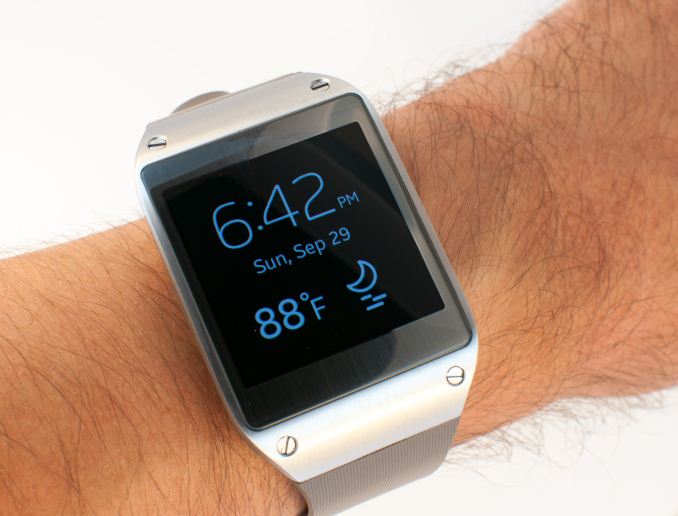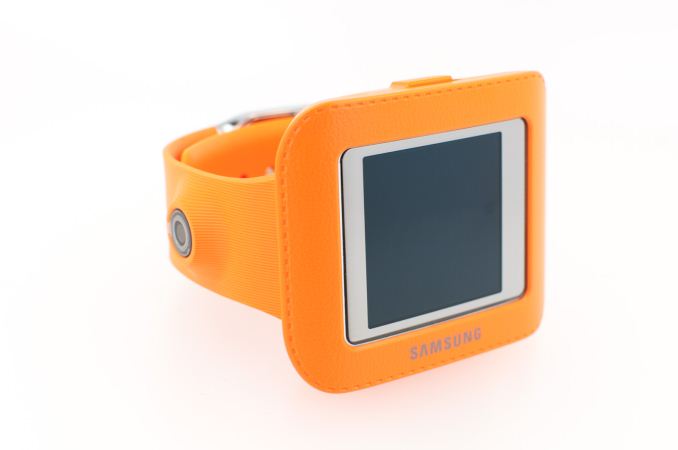Samsung Galaxy Gear Review
by Brian Klug on October 1, 2013 9:00 AM EST- Posted in
- Wearables
- Smartphones
- Mobile
- Galaxy Gear
- galaxy note 3
- watches
Final Thoughts
It's immediately apparent that there's a bit of panic around what happens as the smartphone/tablet markets mature. The incredible growth the leaders in those industries enjoyed over the past few years is addictive, and no one wants to be late to move onto the next thing. Wearables are an obvious target - the incredible amount of attention paid to Google Glass being proof that there is interest, should someone be able to get the formula right.
We've seen many attempts at building smarter watches over the years. Adding functionality to something you already wear seems logical, plus there's historical precedent here (calculator watches from the 80s come to mind). As lofty as the upside is, there's an equally depressing downside however. The stylish, most adored watches aren't those that have a ton of extra functionality added onto them. That's not to say that the two goals are orthogonal, just that industrial design matters even more with a wearable than it does with a smartphone.
Samsung did relatively well with the Galaxy Gear in that department. I don't know that it speaks to me like a luxury timepiece, but it's well built and doesn't feel cheap at all. I think a truly successful smartwatch will have to look first and foremost like a great timepiece, and I don't know that any of the initial players (Samsung included) are really there yet. I'll admit I'm puzzled by the decision to go with a plastic charging cradle that closes over the Gear instead of some connector and a USB cable, so maybe that's the first thing that really needs changing.
Architecturally, Samsung took a different approach to the Galaxy Gear than we've seen from most of the recent attempts (e.g. Pebble, Toq). Rather than optimizing for always on operation, the Galaxy Gear instead is treated like more of a smartphone - designed to be used in bursts, and relying on idle time to extend battery life.
It's sort of insane to think that the Galaxy Gear puts an Exynos 4212 on my wrist. On the flipside, the Galaxy Gear delivers downright smartphone-like battery life at a little more than 5 hours of continuous use and that's without cellular connectivity. The lack of an always on watch face is a bit bothersome since you'd expect something you wear on your wrist to always be able to, you know, tell time. Samsung attempts to mitigate the Gear's lack of an always on mode by using the accelerometer and gyro to detect when you're flipping your wrist to look at your watch face. The unfortunate reality is the gesture doesn't work all of the time, again putting you in a situation where you're wearing something on your wrist that doesn't always behave like a watch at the bare minimum.
It's also sort of crazy to think about Android 4.2, similarly, running on my wrist.
Truth be told, I don't know that either of these things are the right solution, at least today. An 800MHz Cortex A9 with some Mali-400 GPU configuration at 32nm and Android 4.2 are both too much for a watch-like device. In many ways Galaxy Gear feels a like tablet from the early 2000s. They used notebook hardware and notebook software, weren't fast enough, didn't last long enough on a single charge, and didn't have a great user experience. In the case of the Galaxy Gear, Samsung at least leveraged its experience in skinning Android to deliver an experience that felt mostly reasonable on a watch face. But the hardware needed to run the whole thing is excessive and as a result gives you very little battery life.
There are some nicely executed elements of the Galaxy Gear. The device is well built and doesn't feel heavy (although it is a bit bulky). Integration with the Galaxy Note 3 works well. The camera integrated into the wrist strap takes surprisingly decent photos as well. The calling-from-your-wrist experience isn't great though, and the device itself isn't waterproof (which is far more of an issue for something you wear on your wrist than something that lives in your pocket).
Ultimately the Galaxy Gear isn't the perfect solution to wearable computing, but rather a first attempt. It's more a proof of concept that you can own. If we look at Samsung's history in nearly every market we've followed it (SoCs, SSDs, smartphones), the company has a tendency to show up early with the wrong solution, but iterate aggressively to the point where it ends up with a very good solution.
In terms of interim improvement - I'd love to see more/better watch faces, broader compatibility with Samsung phones and a persistent clock. Let's start there and see where it takes us.












70 Comments
View All Comments
et20 - Tuesday, October 1, 2013 - link
Don't worry.I'm sure they'll figure it out in mere minutes after Apple introduces their iWatch.
colonelclaw - Tuesday, October 1, 2013 - link
Indeed. The design of this watch screams 'pre-Apple'. It also screams 'We got to the market 1st!', even though it looks, frankly, ridiculous.In my opinion, something as visible as a watch (this goes for all watches) needs to be an object of beauty, something that when you see on someone else's wrist, you want to get one yourself. Nothing would persuade me to wear this huge plastic lump.
prophet001 - Tuesday, October 1, 2013 - link
I hate it when they give out free Kool-Aid. The swarming is always imminent.bji - Tuesday, October 1, 2013 - link
Those posts were interesting and insightful. Yours ... not so much.Fergy - Wednesday, October 2, 2013 - link
In what way were they interesting and insightful? The Samsung bashing? The Apple worshiping? Or the opinion that the watch isn't for him so nobody should like it?DaHarder - Wednesday, October 2, 2013 - link
Exactly... and those of us who truly love tech can easily see Samsung's effort here as solid and far ahead of the wearable technology game, whereas most other major brands are just sitting by waiting to leach off of the foundation Samsung is laying.steven75 - Wednesday, October 2, 2013 - link
Far ahead? Please. The *watch* display is mostly off. It's a watch that fails to do what every watch since the beginning of time (see what I did there?) has been able to do. Tell time easily!The "waiting to leach off the foundation Samesung is laying" is also comedy gold.
whyso - Tuesday, October 1, 2013 - link
Its so Apple can't sue them over something retarded.RadarTheKat - Thursday, October 3, 2013 - link
I see a lot of comments on these articles that show a lack of comprehension regarding patent law and how it applies. I thought I'd provide a bit of insight here for those who might not be conversant in the topic.Apple's assertion in its lawsuits is that Samsung has copied elements of the iPhone and iPad for which Apple holds several patents. These particular patents are known as design patents. It seems a lot of folks don't take these patents seriously and go as far as to suggest that they should not exist. There is a good reason why they do exist, but to explain this we have to begin with a bit of a side trip and requires that we speak about trademark law. Bear with me on this and hopefully I'll be able to clarify the purpose of design patents and provide some insights into the Apple versus Samsung trial.
Most people are familiar with the idea of a trademark. By way of example, Kellogg, the cereal maker, has a trademark on Tony the Tiger and fought a battle with Exxon over Kellogs' claim that the use of an unnamed tiger in Exxon's advertising violates Kellogg's trademark for Tony the Tiger. Why? For 30 years, Exxon used its tiger character exclusively to promote its gasoline blend, but then, in the 1990's began using it to sell food. Kellogg said consumers are confused by the similarity between the cartoon tigers and may conclude that Kellogg is somehow behind soda, coffee and other items for sale at Exxon's TigerMart stores. The case went back and forth for several years, with Exxon initially winning the case, but ultimately losing on appeal. This case would not seem extraordinary to most people as most folks understand the concept of protecting a unique trademark like Kellogg's Tony the Tiger character.
Now let's look at another case, one that comes closer to the Apple vs Samsung case, but still an application of trademark law. This case is Ferrari vs Robert's Replicas. Back in the 1980's Robert's Replica's was in the business of manufacturing fiberglass kits that replicated the exterior features of Ferrari's Daytona Spyder and Testarossa automobiles. Roberts' copies were called the Miami Spyder and the Miami Coupe, respectively. Ferrari brought suit against Roberts in March 1988 alleging trademark infringement.
Here's what this case was about: After Ferrari vehicles have been on the market for a number of years, the design of those vehicles acquires what's called "secondary meaning", a concept at the heart of trademark law. Secondary meaning refers to an association of a design, like the design of a Ferrari vehicle, with quality and craftsmanship or other positive attributes one might associate with the Ferrari brand. After a design has acquired secondary meaning, trademark law can be applied to protect the company from those who would copy its designs and use them to promote their own products. Robert's copying of Ferrari's iconic designs could confuse the public and dilute the strength of Ferrari's brand. Just the presence of large numbers of replicas would dilute Ferrari's image of exclusivity, causing financial harm to Ferrari. Trademark law, under the concept of secondary meaning, protected Ferrari. The courts ruled in favor of Ferrari in this case and enjoined Roberts from producing the Miami Spyder and the Miami Coupe.
But how does this relate to design patent law?
The problem with using trademark law to protect a company's designs (under trademark law a product design or package design is referred to as "trade dress") is that a product has to be on the market for a long time before its design acquires secondary meaning (i.e. before the design becomes iconic and is seen by consumers as representative of the company behind the product). When competitors come in immediately after a new product design is introduced and copy it, as is the assertion in the Apple vs Samsung case, the originator of the design doesn't have the luxury of time needed for its product design to acquire secondary meaning in the eyes of consumers. Consumers immediately see the same design from multiple companies and so don't grow to associate the design with the company that originated that design.
This is where design patents come in. Where trademark protection of an iconic product design has no expiration, it takes time for a new product to acquire that protection (as stated above). A design patent offers immediate protection of a new and novel design and for a period of 14 years thereafter, giving a company protection of its original designs until they acquire secondary meaning in the market and therefore protection under trademark law. So the design patent serves a valuable function for companies like Ferrari, and Apple.
Nathillien - Friday, October 4, 2013 - link
That's a lot of words to justify rounded corners design "patent" or some other dubious Apple patents like "swipe to do some action" or "bounce back feature".